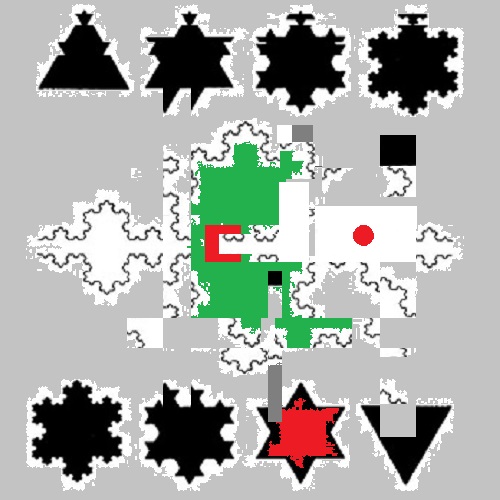The chunk 29 The message -317-
Here she could train for an hour and listen to audiobooks: it was impossible at work, all the time was taken away by customers.
She listened to a lot of books on the one-hour way home and to work, and at the gym at lunchtime. These were popular science lectures on physics, chemistry and astronomy (she listened to several lectures on black holes, of course). Lectures on psychology, lectures by neurosurgeons, plastic surgeons and quantum physicists, books by Pelevin, Akunin, Rubina, and a lot more that was available..Japanese and Chinese, Greek philosophy and philosophy in general..notes of Marcus Aurelius and Buddhist parables..how did her head hold up? Of course, it was empty, just like before. They left only traces, impressions, sensations in her head. More often than not, and better, she remembered what she read. But there wasn't much time to read. If she had a spare moment at work, she tried to understand the mathematical calculations of this Ahmed, from his works: what are statistical modeling methods, fractals, who is Shikio Nayashi and what are his methods. Much was read, little understood.
“COMPLEXITY, as a concept, covers the main aspects of our urban life. When a person walks down the street or contemplates urban landscapes, he often feels an increasing complexity from the smallest urban details to the entire urban scene. The most frequent question is usually related to the origin of this complexity. This has been the subject of a series of studies on the physical aspects of the urban environment and its social dimension. This study attempts to consider another aspect of complexity, which is to assess the degree of complexity of different streetscapes created in two different physical environments (Algeria and Japan), according to multicultural groups of people.” — she read the introduction to Ahmed’s doctoral work.
There was great doubt about the reasonableness of Ahmed's work.
They seemed simply unnecessary, not a single line was written there about for which such a study was done or about its results, practical conclusions can be used. As if they were made just for the sake of doing it. But she didn't write to him about it. She considered her judgments shallow and superficial.
Ольга купила, наконец-то, абонемент в спортзал. Несколько разных фитнесс-залов этой сети разбросаны по городу: один в двух минутах ходьбы от места работы, другой — рукой подать до дома, и еще несколько подальше. Один из дальних она из любопытства посетила тоже, но там ей показалось слишком тесно. В избранных двух залах имелись отдельные помещения с зеркалами во всю стену, которые почти всегда пустовали. Тот, что она посещала во время, а точнее, вместо ланча в рабочие дни, предлагал даже два зеркальных зала: один для единоборств, весь укрытый матами, другой для аэробики с прорезиненным покрытием на полу.
Здесь она могла в течение часа тренироваться и слушать аудиокниги: на работе это невозможно, вс; время отнимали заказчики.
Массу книг Ольга прослушала по пути домой и на работу, и в спортзале в обеденное время. Разная это была литература: научно-популярные лекции по физике, химии, астрономии (она прослушала несколько лекций о ч;рных дырах, конечно), лекции по психологии, лекции нейрохирургов, пластических хирургов и квантовых физиков, книги Пелевина, Акунина, Рубиной, и еще массу того что нашла в общем доступе..японская и китайская философия и философия вообще..записки Марка Аврелия и буддийские притчи..как выдерживала голова? Конечно, там осталось пусто, как и до этого. Остались следы, впечатления, ощущения. Чаще всего, и лучше, она запоминала то, что читала. Но читать времени почти не оставалось. Если появлялась свободная минута на работе, она пыталась разобраться в математических выкладках этого Ахмеда, из его работ: что такое статистические методы моделирования, фракталы, кто такой Шикио Наяши и что такое его методы. Было много прочитано, мало понято.
“COMPLEXITY, as a concept, covers the main aspects of our urban life. When a person walks down the street or contemplates urban landscapes, he often feels an increasing complexity from the smallest urban details to the entire urban scene. The most frequent question is usually related to the origin of this complexity. This has been the subject of a series of studies on the physical aspects of the urban environment and its social dimension. This study attempts to consider another aspect of complexity, which is to assess the degree of complexity of different streetscapes created in two different physical environments (Algeria and Japan), according to multicultural groups of people.” — читала она введение в Ахмедову докторскую работу.
Было большое сомнение в разумности работ Ахмеда. Они казались просто ненужными, там не написали ни одной строки, для чего может быть использовано такое исследование или его итоги, практические выводы. Как будто работу проделали только для того чтобы она была...но она не написала ему об этом. Она считала свои суждения поверхностными и несерьезными.
Свидетельство о публикации №221093001827

